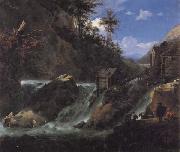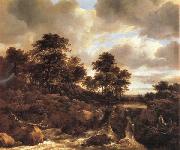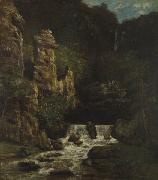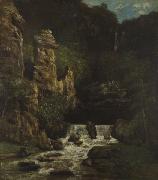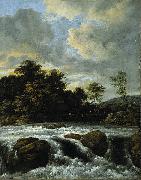Wholesale Oil Painting No Minimum |
|||||||||||
|
|
|||||||||||

|
|||||||||||
|
|
|
||||||||
Jacob van RuisdaelDutch Baroque Era Painter, ca.1628-1682 Ruysdael's favorite subjects are simple woodland scenes, similar to those of Everdingen and Hobbema. He is especially noted as a painter of trees, and his rendering of foliage, particularly of oak leaf age, is characterized by the greatest spirit and precision. His views of distant cities, such as that of Haarlem in the possession of the marquess of Bute, and that of Katwijk in the Glasgow Corporation Galleries, clearly indicate the influence of Rembrandt. He frequently painted coast-scenes and sea-pieces, but it is in his rendering of lonely forest glades that we find him at his best. The subjects of certain of his mountain scenes seem to be taken from Norway, and have led to the supposition that he had traveled in that country. We have, however, no record of such a journey, and the works in question are probably merely adaptations from the landscapes of Van Everdingen, whose manner he copied at one period. Only a single architectural subject from his brush is known--an admirable interior of the New Church, Amsterdam. The prevailing hue of his landscapes is a full rich green, which, however, has darkened with time, while a clear grey tone is characteristic of his seapieces. The art of Ruysdael, while it shows little of the scientific knowledge of later landscapists, is sensitive and poetic in sentiment, and direct and skillful in technique. Figures are sparingly introduced into his compositions, and such as occur are believed to be from the pencils of Adriaen van de Velde, Philip Wouwerman, and Jan Lingelbach. Unlike the other great Dutch landscape painters, Ruysdael did not aim at a pictorial record of particular scenes, but he carefully thought out and arranged his compositions, introducing into them an infinite variety of subtle contrasts in the formation of the clouds, the plants and tree forms, and the play of light. He particularly excelled in the painting of cloudscapes which are spanned dome-like over the landscape, and determine the light and shade of the objects. Goethe lauded him as a poet among painters, and his work shows some of the sensibilities the Romantics would later celebrate. |
||||||||
|
|
||||||||
Landscape with Waterfall
Landscape with Waterfall Painting ID:: 10238 |
1670
Oil on canvas,
101 x 142 cm 1670 Oil on canvas, 101 x 142 cm |
|||||||
|
|
||||||||
ROBERT, HubertFrench Rococo Era Painter, 1733-1808 French painter, draughtsman, etcher and landscape designer. He was one of the most prolific and engaging landscape painters in 18th-century France. He specialized in architectural scenes in which topographical elements derived from the buildings and monuments of ancient and modern Italy and of France are combined in often fantastic settings or fictitious juxtapositions. The fluid touch and rich impasto employed in his paintings |
||||||||
|
|
||||||||
|
|
Landscape with Waterfall
Landscape with Waterfall Painting ID:: 28428 |
mk60
Oil on canvas
123x57"
mk60 Oil on canvas 123x57" |
||||||
|
|
||||||||
Jan Asselijnborn: Netherlands; about 1615 died: Amsterdam, Netherlands ; 1652. Italianate syle painter with big vistas small people and romantic skys |
||||||||
|
|
||||||||
|
|
Landscape with Waterfall
Landscape with Waterfall Painting ID:: 28862 |
mk65
Oil on canvas
18 1/2x21 1/4in
mk65 Oil on canvas 18 1/2x21 1/4in |
||||||
|
|
||||||||
Jacob van RuisdaelDutch Baroque Era Painter, ca.1628-1682 Ruysdael's favorite subjects are simple woodland scenes, similar to those of Everdingen and Hobbema. He is especially noted as a painter of trees, and his rendering of foliage, particularly of oak leaf age, is characterized by the greatest spirit and precision. His views of distant cities, such as that of Haarlem in the possession of the marquess of Bute, and that of Katwijk in the Glasgow Corporation Galleries, clearly indicate the influence of Rembrandt. He frequently painted coast-scenes and sea-pieces, but it is in his rendering of lonely forest glades that we find him at his best. The subjects of certain of his mountain scenes seem to be taken from Norway, and have led to the supposition that he had traveled in that country. We have, however, no record of such a journey, and the works in question are probably merely adaptations from the landscapes of Van Everdingen, whose manner he copied at one period. Only a single architectural subject from his brush is known--an admirable interior of the New Church, Amsterdam. The prevailing hue of his landscapes is a full rich green, which, however, has darkened with time, while a clear grey tone is characteristic of his seapieces. The art of Ruysdael, while it shows little of the scientific knowledge of later landscapists, is sensitive and poetic in sentiment, and direct and skillful in technique. Figures are sparingly introduced into his compositions, and such as occur are believed to be from the pencils of Adriaen van de Velde, Philip Wouwerman, and Jan Lingelbach. Unlike the other great Dutch landscape painters, Ruysdael did not aim at a pictorial record of particular scenes, but he carefully thought out and arranged his compositions, introducing into them an infinite variety of subtle contrasts in the formation of the clouds, the plants and tree forms, and the play of light. He particularly excelled in the painting of cloudscapes which are spanned dome-like over the landscape, and determine the light and shade of the objects. Goethe lauded him as a poet among painters, and his work shows some of the sensibilities the Romantics would later celebrate. |
||||||||
|
|
||||||||
|
|
Landscape with Waterfall
Landscape with Waterfall Painting ID:: 28964 |
mk65
Oil on canvas
20 11/16x24 5/8in
Pitti,Palatine Gallery
mk65 Oil on canvas 20 11/16x24 5/8in Pitti,Palatine Gallery |
||||||
|
|
||||||||
Gustave Courbet1819-1877 French Gustave Courbet Locations was a French painter whose powerful pictures of peasants and scenes of everyday life established him as the leading figure of the realist movement of the mid-19th century. Gustave Courbet was born at Ornans on June 10, 1819. He appears to have inherited his vigorous temperament from his father, a landowner and prominent personality in the Franche-Comte region. At the age of 18 Gustave went to the College Royal at Besancon. There he openly expressed his dissatisfaction with the traditional classical subjects he was obliged to study, going so far as to lead a revolt among the students. In 1838 he was enrolled as an externe and could simultaneously attend the classes of Charles Flajoulot, director of the ecole des Beaux-Arts. At the college in Besançon, Courbet became fast friends with Max Buchon, whose Essais Poetiques (1839) he illustrated with four lithographs. In 1840 Courbet went to Paris to study law, but he decided to become a painter and spent much time copying in the Louvre. In 1844 his Self-Portrait with Black Dog was exhibited at the Salon. The following year he submitted five pictures; only one, Le Guitarrero, was accepted. After a complete rejection in 1847, the Liberal Jury of 1848 accepted all 10 of his entries, and the critic Champfleury, who was to become Courbet first staunch apologist, highly praised the Walpurgis Night. |
||||||||
|
|
||||||||
|
|
Landscape with Waterfall
Landscape with Waterfall Painting ID:: 72371 |
"Landscape with Waterfall," oil on canvas, by the French artist Gustave Courbet. 43 in. x 38 3/4 in. x 2 1/2 in. Yale University Art Gallery, gift of Walter Bareiss, B.S. 1940s. Courtesy of Yale University, New Haven, Conn.
cjr "Landscape with Waterfall," oil on canvas, by the French artist Gustave Courbet. 43 in. x 38 3/4 in. x 2 1/2 in. Yale University Art Gallery, gift of Walter Bareiss, B.S. 1940s. Courtesy of Yale University, New Haven, Conn. cjr |
||||||
|
|
||||||||
Courbet, GustaveFrench Realist Painter, 1819-1877 Gustave Courbet was born at Ornans on June 10, 1819. He appears to have inherited his vigorous temperament from his father, a landowner and prominent personality in the Franche-Comt region. At the age of 18 Gustave went to the College Royal at Besançon. There he openly expressed his dissatisfaction with the traditional classical subjects he was obliged to study, going so far as to lead a revolt among the students. In 1838 he was enrolled as an externe and could simultaneously attend the classes of Charles Flajoulot, director of the cole des Beaux-Arts. At the college in Besançon, Courbet became fast friends with Max Buchon, whose Essais Poetiques (1839) he illustrated with four lithographs. In 1840 Courbet went to Paris to study law, but he decided to become a painter and spent much time copying in the Louvre. In 1844 his Self-Portrait with Black Dog was exhibited at the Salon. The following year he submitted five pictures; only one, Le Guitarrero, was accepted. After a complete rejection in 1847, the Liberal Jury of 1848 accepted all 10 of his entries, and the critic Champfleury, who was to become Courbet's first staunch apologist, highly praised the Walpurgis Night. Courbet achieved artistic maturity with After Dinner at Ornans, which was shown at the Salon of 1849. By 1850 the last traces of sentimentality disappeared from his work as he strove to achieve an honest imagery of the lives of simple people, but the monumentality of the concept in conjunction with the rustic subject matter proved to be widely unacceptable. At this time the notion of Courbet's "vulgarity" became current as the press began to lampoon his pictures and criticize his penchant for the ugly. His nine entries in the Salon of 1850 included the Portrait of Berlioz, the Man with the Pipe, the Return from the Fair, the Stone Breakers, and, largest of all, the Burial at Ornans, which contains over 40 life-size figures whose rugged features and static poses are reinforced by the somber landscape. A decade later Courbet wrote: "The basis of realism is the negation of the ideal. Burial at Ornans was in reality the burial of romanticism." In 1851 the Second Empire was officially proclaimed, and during the next 20 years Courbet remained an uncompromising opponent of Emperor Napoleon III. At the Salon of 1853, where the painter exhibited three works, the Emperor pronounced one of them, The Bathers, obscene; nevertheless, it was purchased by a Montpellier innkeeper, Alfred Bruyas, who became the artist's patron and host. While visiting Bruyas in 1854 Courbet painted his first seascapes. Among them is the Seashore at Palavas, in which the artist is seen waving his hat at the great expanse of water. In a letter to Jules Vall's written in this period Courbet remarked: "Oh sea! Your voice is tremendous, but it will never succeed in drowning out the voice of Fame shouting my name to the entire world." Courbet was handsome and flamboyant, naively boastful, and aware of his own worth. His extraordinary selfconfidence is also evident in another painting of 1854, The Meeting, in which Courbet, stick in hand, approaches Bruyas and his servant, who welcome him with reverential attitudes. It has recently been shown that the picture bears a relationship to the theme of the Wandering Jew as it was commonly represented in the naive imagery of the popular Épinal prints. Of the 14 paintings Courbet submitted to the Paris World Exhibition of 1855, 3 major ones were rejected. In retaliation, he showed 40 of his pictures at a private pavilion he erected opposite the official one. In the preface to his catalog Courbet expressed his intention "to be able to represent the customs, the ideas, the appearance of my own era according to my own valuation; to be not only a painter but a man as well; in short, to create living art." One of the rejected works was the enormous painting The Studio, the full title of which was Real Allegory, Representing a Phase of Seven Years of My Life as a Painter. The work is charged with a symbolism which, in spite of obvious elements, remains obscure. At the center, between the two worlds expressed by the inhabitants of the left and right sides of the picture, is Courbet painting a landscape while a nude looks over his shoulder and a child admires his work. Champfleury found the notion of a "real allegory" ridiculous and concluded that Courbet had lost the conviction and simplicity of the earlier works. Young Ladies by the Seine (1856) only served to further convince the critic of Courbet's diminished powers. But if Courbet had begun to disappoint the members of the old realist circle, his popular reputation, particularly outside France, was growing. He visited Frankfurt in 1858-1859, where he took part in elaborate hunting parties and painted a number of scenes based on direct observation. His Stag Drinking was exhibited in Besançon, where Courbet won a medal, and in 1861 his work, as well as a lecture on his artistic principles, met with great success in Antwerp. With the support of the critic Jules Castagnary, Courbet opened a school where students dissatisfied with the training at the cole des Beaux-Arts could hear him extol the virtues of independence from authority and dedication to nature. |
||||||||
|
|
||||||||
|
|
Landscape with Waterfall
Landscape with Waterfall Painting ID:: 74005 |
oil on canvas, by the French artist Gustave Courbet. 43 in. x 38 3/4 in. x 2 1/2 in. Yale University Art Gallery, gift of Walter Bareiss, B.S. 1940s. Courtesy of Yale University, New Haven, Conn.
Date circa 1865
cyf oil on canvas, by the French artist Gustave Courbet. 43 in. x 38 3/4 in. x 2 1/2 in. Yale University Art Gallery, gift of Walter Bareiss, B.S. 1940s. Courtesy of Yale University, New Haven, Conn. Date circa 1865 cyf |
||||||
|
|
||||||||
Jacob Isaacksz. van Ruisdaelpainted Landscape with Dune and Small Waterfall in 1646 |
||||||||
|
|
||||||||
|
|
Landscape with Waterfall
Landscape with Waterfall Painting ID:: 92654 |
c. 1665
Medium oil on canvas
Dimensions 27 5/16 x 22 1/16 in. (69.4 x 56 cm)
cjr c. 1665 Medium oil on canvas Dimensions 27 5/16 x 22 1/16 in. (69.4 x 56 cm) cjr |
||||||
|
|
||||||||
|
Jacob Isaacksz. van Ruisdael painted Landscape with Dune and Small Waterfall in 1646 Landscape with Waterfall c. 1665 Medium oil on canvas Dimensions 27 5/16 x 22 1/16 in. (69.4 x 56 cm) cjr |
||||||||
|
|
||||||||
|
Prev Next
|
||||||||
|
|
||||||||
|
Related Paintings to Jacob Isaacksz. van Ruisdael :. |
||||||||
|
|
||||||||
|
CONTACT US |



